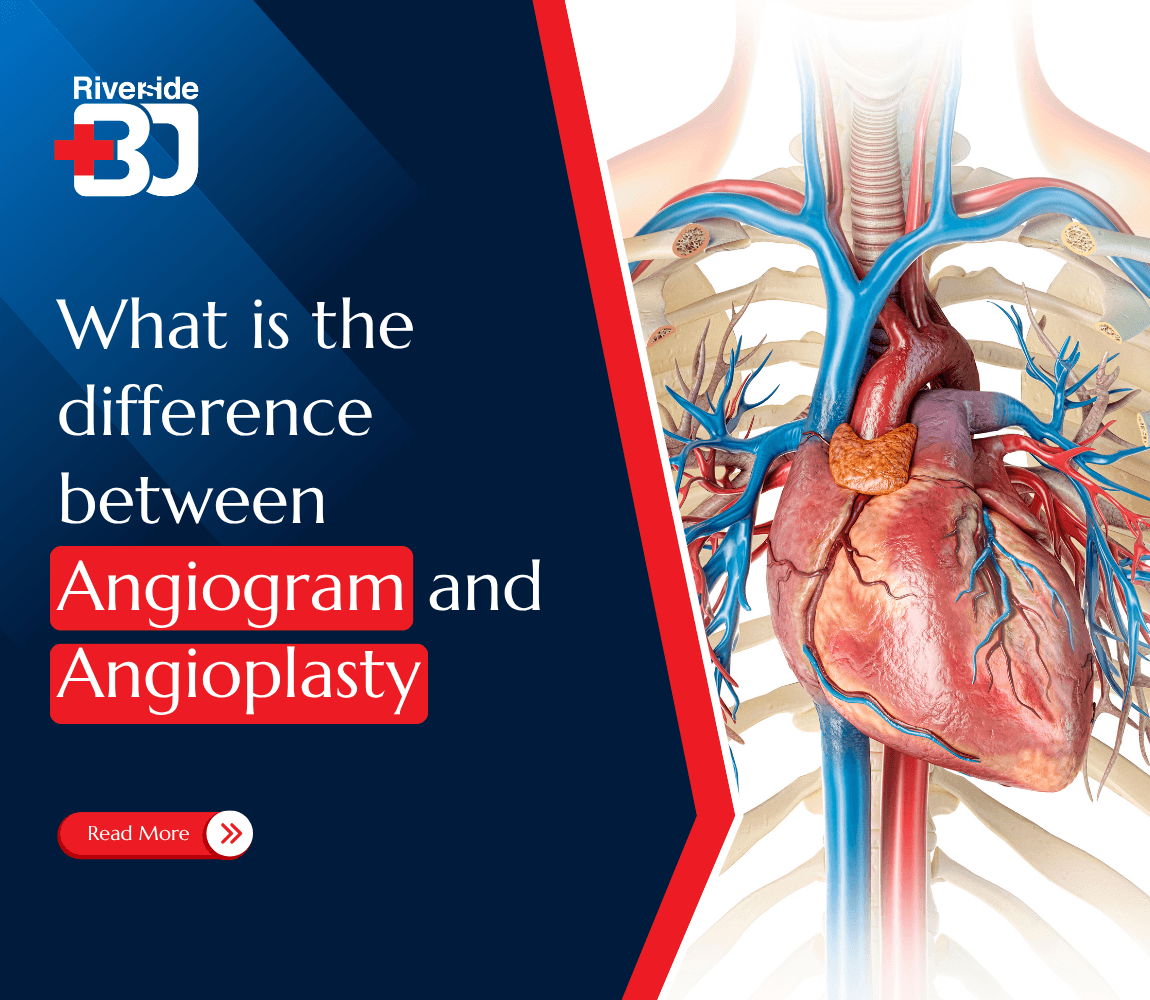An angiogram diagnoses artery issues, while angioplasty treats them by opening blocked arteries. Understanding the difference is crucial for informed decision-making.
According to the NIH, cardiovascular diseases account for over 28% of deaths in India. Hence, making a timely diagnosis and treatment is essential.
In this blog, we’ll explore angiogram vs. angiography vs. angioplasty. We will outline and understand the procedures, risks, and costs involved.
This guide explains everything, from what angioplasty is to why doctors perform angiography, including angiogram vs angiography. We’ll also cover types of angioplasty to help you better understand your options.

What is Angiography?
Doctors use angiography as a diagnostic imaging test to detect blockages or abnormalities in blood vessels. They inject a special dye to highlight arteries on an X-ray screen.
This test helps doctors visualise blood flow clearly.
Understanding what is the difference between angiogram and angioplasty starts with knowing angiography’s vital role in diagnosing heart conditions.
Why Angiography Is Done:
Doctors typically recommend angiography to identify blockages in the coronary arteries that cause chest pain or breathlessness. Doctors also perform it before surgeries or while placing stents to plan treatment properly.
Knowing the reasons for angiography is important for understanding its role in accurate and timely cardiovascular care. As a result, this insight helps guide effective intervention when needed.
Procedure:
The difference between angiogram and angioplasty begins with understanding the angiogram procedure.
- To begin with, a catheter is inserted through the wrist or groin into a blood vessel.
- Next, a special dye is injected to highlight the arteries.
- Subsequently, X-ray images are captured to observe blood flow and blockages.
- The entire process is usually quick and minimally invasive.
Knowing the difference between angiogram and angioplasty is essential to grasp the significance of this diagnostic step. It also prepares patients for the steps involved during the test.
Cost:
Angiography in India usually costs between ₹10,000 and ₹35,000, depending on the hospital type and urgency. Angiography cost in Mumbai, Bangalore, Delhi, Gurugram, and other Tier 1 cities may vary slightly depending on the hospital and location. Although sometimes, combined procedures can increase the costs.
Understanding the costs involved is crucial when trying to learn the difference between angiogram and angioplasty.
Ultimately, knowing angiography and angioplasty costs helps patients make informed and realistic medical decisions.
Complications Of Angiography
Although generally safe, risks may include bleeding, bruising, or allergic reactions to the dye. Rarely, a heart attack or stroke may also occur.
However, in some cases, complications can be more severe. According to Stanford Health Care, approximately 1 in 4,000 patients may suffer serious reactions like severe asthma or airway swelling. It then requires intravenous medication and extended observation.
Besides understanding the difference between angiogram and angioplasty, patients often ask how much time it takes for angiography. This helps them assess readiness for the procedure and prepare for its after-effects.
Before diving deeper, it’s equally important to understand what angioplasty is.
What is Angioplasty?
Doctors perform angioplasty as a minimally invasive procedure to open blocked or narrowed blood vessels in the heart. It involves inflating a balloon to restore blood flow and may include stent placement to keep arteries open.
Naturally, to fully understand what is the difference between angiogram and angioplasty, one must first recognise what angioplasty entails. It plays a curative role in treating cardiovascular blockages and restoring healthy blood flow.
Types Of Angioplasty
Understanding the types of angioplasty is essential to recognising how each method targets specific arterial issues.
Moreover, when exploring what is the difference between angiogram and angioplasty, these variations provide insights into appropriate treatment choices.
1. Balloon Angioplasty
A balloon-tipped catheter is inserted into the blocked artery and inflated to widen it. No stent is placed. Hence, making it suitable for minor or early-stage arterial blockages.
2. Stent Angioplasty
This involves placing a mesh tube (stent) in the artery after it is widened. The stent stays permanently. Therefore, keeping the artery open is the most common angioplasty technique.
3.Rotational Angioplast
This method uses a tiny rotating device to break down hardened, calcified plaque. Doctors typically choose it when balloon angioplasty isn’t effective and often follow it with stent placement.
4.Laser Angioplasty
Laser angioplasty uses high-energy beams to vaporise the blockages in complex or soft plaque cases. It is ideal when traditional tools can’t access the blockage and require advanced imaging support.
Each method plays a vital role in treating the various types of blockages. Therefore, knowing the difference between angiogram and angioplasty helps patients choose the right treatment with improved clarity.
When Is Angioplasty Recommended?
Angioplasty specialist doctors typically advise angioplasty when blocked arteries stop responding to medication or lifestyle changes. It becomes crucial once symptoms like chest pain or breathlessness worsen.
In many cases, they recommend it after a heart attack or for patients experiencing severely restricted blood flow.
Therefore, understanding when doctors recommend angioplasty for timely treatment. This clarity becomes vital when learning what the difference is between angiogram and angioplasty in cardiac care planning.
1. Procedure
The procedure for angiogram lays the groundwork for angioplasty, which begins by inserting a catheter into a blocked artery.
Then, a balloon inflates to widen the vessel, followed by optional stent placement.
Therefore, grasping this process is essential when patients are learning the difference between angiogram and angioplasty during diagnosis and treatment planning.
2. Cost
Angioplasty in India generally ranges between ₹1.2 lakh and ₹3 lakh, depending on the hospital facilities and stent quality.
Moreover, for patients evaluating the cost of angiography and angioplasty, budget considerations can significantly shape the treatment journey.
Thus, comparing pricing becomes relevant when understanding the broader medical and financial scope of angioplasty versus angiography.
3. Complications of Angioplasty
Though considered safe, angioplasty may lead to bleeding, artery damage, or, in rare cases, heart attacks or strokes. Additionally, clotting and restenosis are other potential concerns post-procedure.
Notably, as per The Economic Times, nearly 4.5 lakh patients undergo angioplasty annually in India. This showcases its wide adoption despite low but possible risks.
Now, let us explore and analyse what is the difference between angiogram and angioplasty in greater detail.
Difference Between Angiogram And Angioplasty
Understanding the difference between angiogram and angioplasty is vital for patients facing cardiovascular diagnosis and treatment.
These procedures, although connected, serve very different medical purposes in the heart care journey.
1. Purpose and Function
Knowing the difference between angiogram and angioplasty begins with their core objectives.
On the one hand, an angiogram is purely diagnostic. It identifies narrowed arteries using X-rays and contrast dye.
In contrast, angioplasty is a treatment to open the narrowed arteries. Therefore, the differences between angiogram and angioplasty lie in their purposes; one detects the problem, the other fixes it.
Thus, both are crucial to cardiovascular health, though their roles are entirely distinct. They often follow one another during patient care.
2. Procedure and Tools Involved
Naturally, the methods used in each procedure reflect their function.
During an angiogram, only imaging tools and contrast dye are used. Conversely, angioplasty involves balloons or stents to widen the arteries.
Both procedures use catheters, but angioplasty is far more involved.
Hence, the difference between angiogram and angioplasty can be understood through the complexity of the tools used. Furthermore, this distinction defines diagnosis and intervention.
3. Duration and Recovery
While an angiogram takes about 30 minutes, angioplasty may take longer depending on the severity of the patient’s condition. Moreover, angioplasty demands more post-procedure care.
The recovery, post an angiogram, is faster, with patients often being discharged within hours. Whereas an angioplasty may require hospitalisation for a day or more.
As a result, the difference between angiogram and angioplasty becomes clearer from the recovery demands. Each has distinct timelines and physical impacts on the patient.
4. Cost and Risk Considerations
Angioplasty, being a treatment, is more expensive than angiography. Additionally, the risks, especially when compared to angiography risks, are comparatively higher due to stent placement and arterial manipulation.
On the other hand, angiograms are cheaper and carry fewer complications. Still, both have a few rare side effects, like allergic reactions.
Therefore, understanding the difference between angiogram and angioplasty in terms of their costs and risks is crucial. Patients must weigh their options carefully during heart care decisions.
Knowing the difference between angiogram and angioplasty helps patients understand their diagnosis and treatments with greater confidence.
Since both procedures address different stages of heart care, it’s natural to wonder if they can be performed together.
Can Angiogram And Angioplasty Be Done At The Same Time?
Yes, doctors can perform both procedures together when quick intervention is essential. Doctors usually perform this in one session to avoid delays and prevent further complications.
In fact, if they detect a severe blockage during an angiogram, they may perform angioplasty immediately to restore blood flow. This combined approach often reduces hospital time and helps in quicker recovery.
Naturally, knowing the difference between angiogram and angioplasty helps understand their smooth transition from diagnosis to treatment.
- Doctors may combine both procedures during emergencies, especially after a minor heart attack.
- This method avoids separate hospital visits and reduces patient anxiety.
- It is typically carried out in advanced catheterisation labs for efficiency.
- Sometimes, it helps delay or prevent complex procedures like bypass surgery.
Occasionally, angioplasty is deferred when the blockage doesn’t need an urgent intervention or if a pacemaker is being considered. Yet, when done together, it supports faster outcomes, particularly in acute conditions.
Therefore, when asking for the difference between angiogram and angioplasty, it’s vital to also explore timing. This is especially relevant when discussing angiogram vs. angiography vs. angioplasty for treatment decisions and cost clarity.
To further clear common confusion, it’s essential to break down the terms: angiogram vs angiography vs angioplasty.
Angiogram vs. Angiography vs. Angioplasty
Understanding cardiovascular terms is crucial for patients. So, knowing the difference between angiogram and angioplasty, and angiography removes confusion.
Additionally, terms like angiography can appear interchangeable, yet each serves a unique medical purpose.
1. Angiogram: The Diagnostic Image
An angiogram refers to the actual image captured during the angiography process. Essentially, it visualises the blood vessels after dye injection.
Interestingly, one must understand what is the difference between angiogram and angioplasty to see how angiograms initiate treatment.
Moreover, the angiogram procedure provides clarity on blockages. Hence, enabling timely decisions about further interventions like angioplasty or even implanting a pacemaker.
2. Angiography: The Diagnostic Procedure
Doctors use angiography to capture an angiogram. Through X-ray imaging, it tracks contrast dye through the arteries.
Unlike treatment-oriented procedures, angiography’s goal is to detect blockages. Therefore, doctors use it to assess whether bypass surgery or stenting is required.
Ultimately, when exploring the difference between angiogram and angioplasty, angiography defines the initial investigative stage of care.
3. Angioplasty: The Interventional Treatment
Angioplasty treats narrowed arteries after an angiogram diagnosis. A balloon inflates to open vessels, often with a stent placement.
Therefore, recognising the difference between an angiogram and angioplasty highlights how one diagnoses while the other treats.
Besides its therapeutic role, doctors prefer angioplasty for specific artery blockages because it supports faster recovery than surgery.
4. Common Confusion: Clarifying the Three Terms
Despite similar-sounding names, each term has a specific function in cardiology. Therefore, confusion around angiogram vs. angiography vs angioplasty is understandable.
Patients often ask how much time it takes for an angiography, unaware that it differs from angioplasty, which has many steps during treatment.
Thus, understanding these differences empowers a patient to make better decisions, especially regarding angiography and angioplasty costs and the types of angioplasty available.
Distinguishing the difference between angiogram and angioplasty, and angiography supports improved patient awareness. Also, clarifying these terms helps people discuss risks and treatment options confidently with healthcare providers.
Now that we know the difference between angiogram and angioplasty, and angiography, let’s see which one is better. Angioplasty or angiography?

Which Is Better: Angioplasty Or Angiography?
Choosing between angioplasty and angiography depends entirely on the individual’s condition and the stage of diagnosis.
Therefore, understanding the difference between angiogram and angioplasty helps determine which procedure suits the patient best.
1. Angiography: The First Step in Diagnosis
When exploring the difference between angiogram and angioplasty, angiography is clearly diagnostic in nature. It helps doctors evaluate the severity of the arterial blockages using a contrast dye and imaging.
Moreover, angiography answers early concerns such as why the doctors perform it and how long the procedure takes.
Thus, while it doesn’t treat, it guides whether further action, like angioplasty, is necessary.
2. Angioplasty: The Actual Treatment Solution
Unlike angiography, angioplasty actively treats narrowed or blocked arteries. It follows diagnostic clarity, often from angiography or angiogram images.
Importantly, knowing the difference between angiogram and angioplasty helps patients understand when they move from diagnosis to treatment. Angioplasty often involves placing a stent or using a balloon to restore the blood flow.
In many urgent cases, it prevents the need for more invasive procedures and stabilises patients with high-risk blockages quickly.
3. Choosing Between Them: Context Matters
One cannot determine which is better without considering the patient’s symptoms, risk level, and urgency. Still, the key lies in knowing the difference between angiogram and angioplasty before choosing.
While angioplasty offers direct relief, angiography guides decision-making by identifying the blockage’s location and severity.
Ultimately, consult professionals and refer to HeartSmart-Living practical tips for a healthy heart for a long-term heart strategy.
Deciding which is better, angioplasty or angiography, depends on the condition’s stage. Knowing the difference between angiogram and angioplasty ensures informed, timely decisions in cardiac care.
Conclusion
Understanding the difference between angiogram and angioplasty is crucial for making informed decisions relating to the heart’s health.
While an angiogram (or angiography) helps diagnose blockages, angioplasty is a treatment to restore blood flow.
Each has distinct procedures, costs, and complications. In some cases, both may be done together. Weighing angiogram vs. angiography vs. angioplasty helps clarify their roles.
Do you feel unsure about when doctors recommend angioplasty or how long angiography takes? Visit Riverside B&J Hospital, Mumbai’s trusted cardiac hospital.
Book for consultation today for an expert advice, transparent angiography and angioplasty costs, and compassionate treatment from skilled cardiologists.
FAQs
Is Angioplasty The Same As Angiogram?
No. The difference between angiogram and angioplasty lies in the diagnosis and purpose of the treatment.
Can An Angiogram And Angioplasty Be Done At The Same Time?
Yes, if a blockage is found during an angiography, angioplasty may follow immediately as treatment.
Can An Angiogram Clear Blockage?
No, an angiogram only detects blockages. An angioplasty is required to treat and restore blood flow.
Can Angiography Be Done Without Angioplasty?
Absolutely, angiography is often performed alone just to assess arteries without immediate intervention or angioplasty.
Does Angioplasty Remove Blockage?
Yes, angioplasty clears blockages using a balloon..
Can 100% Blocked Arteries Be Opened With Angioplasty?
Sometimes, yes. However complex, fully blocked arteries may need surgery instead of angioplasty for restoration.
What Is The Age Limit For An Angiogram?
There’s no fixed age limit, but risks increase with age, depending on the patient’s health status.
Do They Insert Stents During An Angiogram?
No. The difference between angiogram and angioplasty is that stents are included only in angioplasty procedures.

